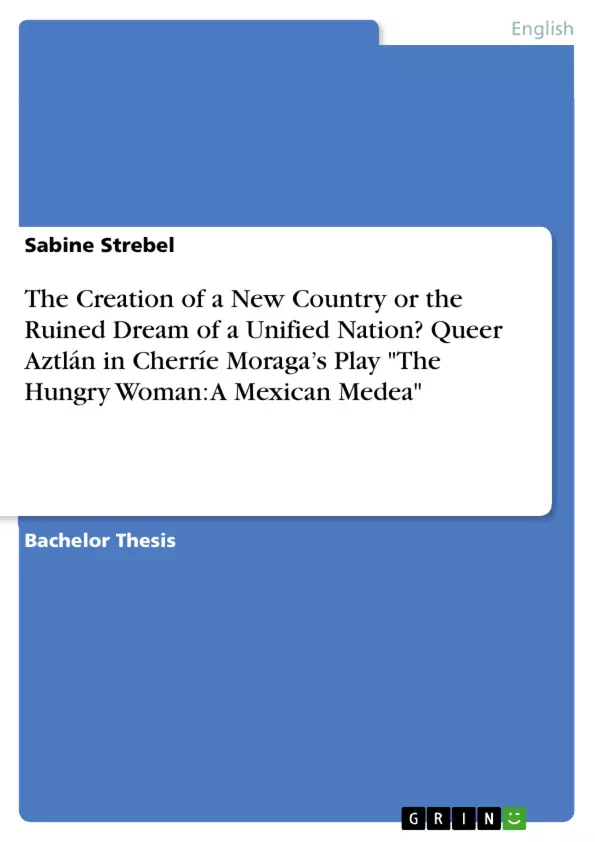Diese Bachelorarbeit untersucht die Darstellung von „Queer Aztlán“ in Cherríe Moragas Theaterstück "The Hungry Woman: A Mexican Medea", und wie der Untergang der Protagonistin Medea exemplarisch auch für den Untergang des reformierten Aztlán steht. Der Begriff „Queer Aztlán“ stammt aus einem ihrer Essays von 1993.
Als Einstieg in meine Untersuchung beleuchte ich in kurzer Form die geschichtlichen Ereignisse, die zum Chicano Movement führten. In dieser Zeit wurde „Aztlán“, der Legende nach das ursprüngliche Heimatland der Azteken, zu einem Symbolbild für den Chicano Nationalismus. Heutzutage bezieht sich Aztlán auf den Südwesten der USA. Da sich die Amerikaner mit mexikanischer Herkunft in den USA benachteiligt fühlten, forderten sie eine Gleichstellung in verschiedenen Bereichen des gesellschaftlichen Lebens, u.a. Zugang zu Bildung und politische Teilhabe. Erweiternd gehe ich auch darauf ein, welche Einflüsse diese Bewegung im Bereich des Chicano Theaters hatte. Moraga stellt in ihrem Essay heraus, dass diese Bewegung problematischerweise auch die patriarchalen Strukturen der weißen Amerikaner auf ihre Familien übertrugen und Frauen, sowohl im privaten als auch im öffentlichen Leben, eine niedere Rolle zugeschrieben wurde. Außerdem wurden auch homosexuelle Chicano/a Einwohner von der Bewegung ausgeschloßen und ihre Dienste im Sinne der Gemeinschaft nicht anerkannt. Daher fordert Moraga eine Erweiterung des Konzepts „Aztlán“ um die Bezeichnung „Queer Aztlán“. Ein Land in dem alle Chicano/as unabhängig von Geschlecht, Sexualität, Klasse, etc. leben können.
Table of Contents
- Introduction
- The Chicano Movement and Chicano Theatre
- The Dream of Queer Aztlán
- The Hungry Woman: A Mexican Medea
- Place and Setting: Desired Aztlán and the Exile Phoenix/ Tamoanchán
- Messenger between this World and the Other: Chac-Mool
- Desperate Captivity in Two Worlds: Medea
- Conclusion
- Works Cited
Objectives and Key Themes
This Bachelor's thesis examines the depiction of "Queer Aztlán" in Cherríe Moraga's play The Hungry Woman: A Mexican Medea and how the downfall of the protagonist Medea is exemplary for the downfall of the reformed Aztlán. The concept of "Queer Aztlán" originates from one of her essays from 1993.
- The historical events that led to the Chicano Movement
- The influence of the Chicano Movement on Chicano Theatre
- Moraga's critique of the Chicano Movement's patriarchal structures
- The concept of "Queer Aztlán" as a place of inclusivity for all Chicano/as
- The depiction of Aztlán and the exile Phoenix in Moraga's play The Hungry Woman: A Mexican Medea
Chapter Summaries
The first chapter introduces the play The Hungry Woman: A Mexican Medea and its context in contemporary US society. It highlights the ongoing struggles for equality faced by non-white Americans, women, and LGBTQ+ individuals, drawing parallels between the play's themes and current events.
The second chapter delves into the origins of the Chicano Movement and its impact on Chicano Theatre. It explains the historical context and the movement's goals, focusing on the development of "El Plan Espiritual de Aztlán" as a symbol of Chicano nationalism.
Chapter four analyzes the play's setting and characters. It explores the dichotomy between the desired Aztlán and the exile Phoenix/ Tamoanchán, highlighting the characters' feelings of otherness and isolation within a patriarchal and conflict-ridden society.
Keywords
The key terms and focus topics of this thesis include: Queer Aztlán, Chicano Movement, Chicano Theatre, Chicana, patriarchal structures, ethnic conflicts, The Hungry Woman: A Mexican Medea, Medea, Chac-Mool, Luna, Aztlán, exile, Phoenix.
- Quote paper
- Sabine Strebel (Author), 2018, The Creation of a New Country or the Ruined Dream of a Unified Nation? Queer Aztlán in Cherríe Moraga’s Play "The Hungry Woman: A Mexican Medea", Munich, GRIN Verlag, https://www.grin.com/document/459309



